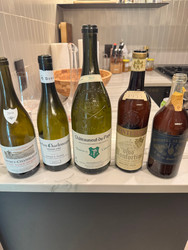Trump Tariffs on Fine Wine - Past History and Future Expectations
Feb 6th 2025
For wine collectors, sommeliers, and anyone who enjoys a great glass of Bordeaux or Barolo, the Trump tariffs on European wines were more than just an economic policy. They shook up the entire fine wine industry. These tariffs, which reached as high as 25% on certain wines from France, Italy, and Spain, were initially imposed as part of a broader trade dispute with the European Union over subsidies to Airbus. But their impact extended far beyond trade politics, altering the way fine wines were priced, imported, and consumed in the United States.
The Immediate Impact: Price Spikes and Supply Chain Disruptions
When the tariffs went into effect, importers and retailers had little time to react. Suddenly, wines that were already expensive saw price hikes that put them out of reach for many consumers. A $50 bottle of Burgundy or Chianti Classico, for example, could suddenly cost $60 or more at retail, a jump that significantly altered purchasing behavior. Restaurants, already operating on razor thin margins, faced a dilemma. Retailers on premise and off premise had to either absorb the increased costs or pass them on to diners. Many simply chose to reduce their selection of European wines, replacing them with domestic or South American alternatives.
Importers, who typically operate on small margins, were hit especially hard. The nature of the fine wine business requires purchasing large allocations of wine months or even years in advance, often before the final price to the consumer is even determined. When the tariffs were implemented, many had no choice but to either eat the costs or renegotiate pricing with European producers, neither of which were easy options. Some importers canceled orders altogether, leading to a decline in the availability of sought after vintages in the U.S. market.
How the Tariffs Shifted Consumer Habits
The fine wine market in the U.S. has always been shaped by global economic forces, but the Trump tariffs accelerated a shift in consumer preferences. While high end wine collectors were still willing to pay the premium for top tier French and Italian wines, everyday drinkers started looking elsewhere.
This was a boon for American wineries, particularly those in California, Oregon, and Washington, which saw increased demand as European options became less affordable. It also opened the door for regions like Argentina, Chile, and Australia to gain a stronger foothold in the U.S. market. Wine lovers who once defaulted to a bottle of Sancerre or Chianti started exploring Oregon Pinot Noir and Napa Valley Sauvignon Blanc.
Retailers adapted as well, increasing their stock of tariff-free wines and focusing marketing efforts on alternatives that delivered similar styles at a more reasonable price. For example, consumers who were once loyal to white Burgundy might have found themselves exploring Chardonnay from Sonoma’s Russian River Valley instead.
The Long-Term Ramifications on the Wine Trade
Even though these tariffs were eventually lifted, their effects still linger in the fine wine world. The disruption caused by the tariffs forced many importers to rethink their business models, with some diversifying their portfolios to reduce dependency on French and Italian wines. Others streamlined their operations, focusing on higher margin wines to compensate for the losses incurred during the tariff period.
For European wineries, the experience was a wake up call. Many had to find new markets for their wines or accept lower profit margins to remain competitive in the U.S. Some smaller producers, who relied heavily on American buyers, struggled to regain their foothold after the tariffs were lifted.
In the broader sense, the tariffs highlighted just how fragile the global wine trade can be. It reinforced the importance of having diversified markets and underscored how quickly economic policy can impact an industry that, at its core, is built on tradition, craftsmanship, and long term planning.
Looking Ahead: Lessons for Wine Collectors and Enthusiasts
For wine collectors, the tariff period offered some key lessons. First, it demonstrated the value of diversification not just in wine investment, but in drinking habits. Those who were willing to explore wines from emerging regions often found excellent alternatives at better price points.
Second, it reinforced the importance of building relationships with trusted retailers and importers. Many savvy wine buyers were able to weather the storm by working closely with their local wine shops, getting early access to allocations before price hikes took effect.
Finally, it reminded everyone that wine, for all its romance and history, is still a business subject to global trade policies. While it is easy to get caught up in the artistry of winemaking, external factors like tariffs, climate change, and economic shifts all play a role in shaping what ends up in your glass.
Final Thoughts
The Trump tariffs on fine wine may have been a temporary disruption, but they left a lasting mark on the industry. They reshaped consumer behavior, pushed retailers and importers to adapt, and even helped boost domestic wine sales. For wine lovers, they served as a reminder that even the finest Bordeaux or Barolo is not immune to the forces of global trade.
While today’s market is stabilizing, the experience underscores the importance of staying informed. Understanding how trade policies impact wine prices can help you make smarter buying decisions and maybe even discover a new favorite wine region or varietal.

